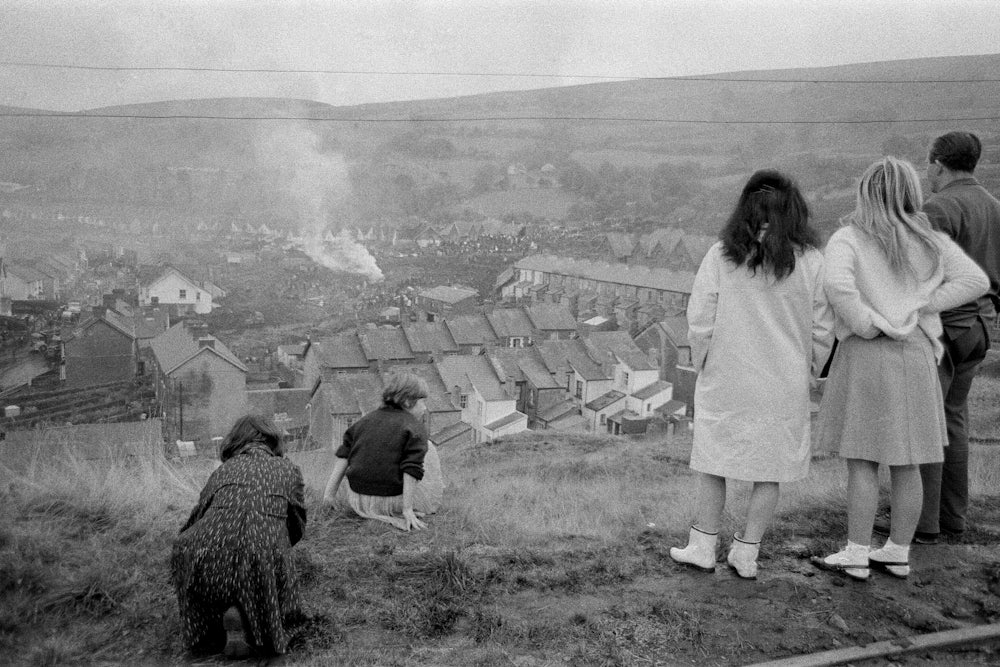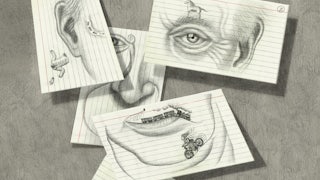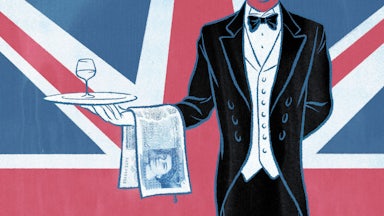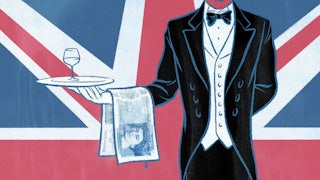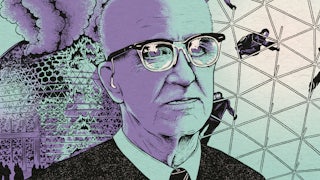When it finally happened, shortly after nine o’clock in the morning on October
21, 1966—when the teetering pile of mining waste known as a coal tip collapsed
after days of heavy rain and an avalanche of black industrial sludge swept down
the Welsh mountainside into the village of Aberfan,
when rocks and mining equipment
from the colliery slammed into people’s homes and the schools were buried and
116 young children were asphyxiated by this slurry dark as the river Styx—the
anguished public response was that someone should have seen this disaster
coming, ought to have predicted it.
Someone did.
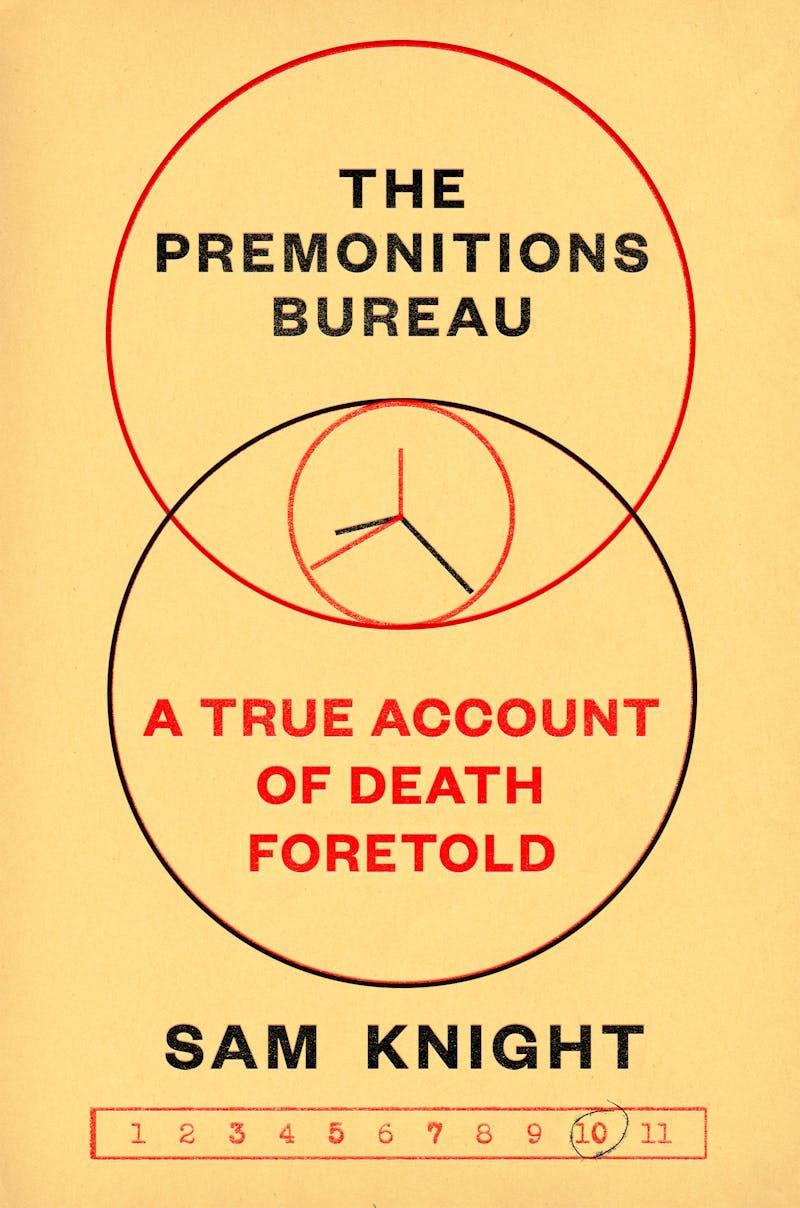
Or at least, they claimed they had. Shortly after the tragedy at Aberfan, several women and men recalled having eerily specific premonitions of the event. A piano teacher named Kathleen Middleton awoke in North London, only hours before the tip fell, with a feeling of sheer dread, “choking and gasping and with the sense of the walls caving in.” A woman in Plymouth had a vision the evening before the disaster in which a small, frightened boy watched an “avalanche of coal” slide towards him but was rescued; she later recognized the child’s face on a television news segment about Aberfan. One of the children who died had first dreamt of “something black” smothering her school. Paul Davies, an 8-year-old victim, drew a picture the night before the catastrophe that showed many people digging in a hillside. Above the scene, he had written two words: The End.
Premonitions this dramatic and alarming are likely rare. But most of us have experienced odd coincidences that make us feel, even for an instant, that we have glimpsed the future. A phrase or scene that triggers a jarring sensation of déjà vu. Thinking of someone right before they text or call. Inexplicably dreaming about a long-lost acquaintance or relative only to wake and find that they have fallen ill or died. It’s mostly accepted that these are not really forms of precognition or time travel but instead fluky accidents or momentary brain glitches, explainable by science. And so we don’t give them a second thought or take them that seriously. But what if we did?
The
Premonitions Bureau, an
adroit debut from The New Yorker staff writer Sam Knight, draws us into a world not that far gone in
which psychic phenomena were yet untamed by science and uncanny sensations
still whispered of the supernatural, of cosmic secrets. Knight’s book registers
the spectral shockwaves that rippled out from Aberfan through the human
instrument of John Barker, a British psychiatrist who began cataloguing and
investigating the country’s premonitions and portents in the wake of the
accident. Barker spent his career seeking out the hidden joints between
paranormal experience and modern medicine, asking scientific questions about the
occult that we have now agreed no longer to ask. In Knight’s skillful hands,
the life of this forgotten clinician becomes a meditation on time and a window
through which we can perceive the long human history of fate and foresight.
It’s also a tale about how we decide what is worthy of science and what it
feels like to be left behind. It is a story about a scientific revolution that
never happened.
Forty-two years old when the country learned of Aberfan, John Barker was a Cambridge-educated psychiatrist of terrific ambition and rather middling achievement. In his thirties, he had been an unusually young hospital superintendent at a facility in Dorset; a nervous breakdown led to his demotion and reassignment, by the mid-’60s, to Shelton Hospital, where he cared for about 200 of the facility’s thousand patients. Shelton was a Victorian-era asylum in western England, not far from Wales, and a hellish world unto itself. Local doctors called it the “dumping ground,” this 15-acre gothic facility of red-brick buildings hidden behind red-brick walls, where women and men suffering from mental illness were deposited for the rest of their lives. One-third of Shelton’s population had never received a single visitor. Like other mental health facilities in midcentury Britain, it was a place of absolutely crushing neglect. “Nurses smoked constantly,” Knight writes, “in part to block out Shelton’s all-pervading smell: of a house, locked up for years, in which stray animals had occasionally come to piss.” Every week or two, another suicide. “The primary means of discharge was death.”
As a clinician, Barker was tough and demanding. He was also complicated (like all of us) and tough to caricature. Barker had arrived at Shelton as calls for psychiatric reform were growing louder, and he supported efforts to make conditions “as pleasant as possible” for the hospital’s permanent residents, including removing locks from most of the wards and arranging jazz concerts. But he also favored aversion shock therapies and once performed a lobotomy—which, to his credit, he later regretted. At any rate, Barker’s true passion lay elsewhere. As a young medical student, he collected ghost stories from nurses and staff at the London hospital where he was training: sudden and unaccountable cold presences late at night, spectral ward sisters who shouldn’t have been there and who vanished when you looked twice. A “modern doctor” committed to rational methods, his interest in all things paranormal led him to join Britain’s Society for Psychical Research, whose members had been studying unexplained occult phenomena since 1882. Barker had a crystal ball on his desk and spent his weekends at Shelton rambling around haunted houses with his son. He was a man caught between worlds who would eventually fall through the cracks.
The day following the disaster, Barker showed up in Aberfan to interview residents for an ongoing project about people who frightened themselves to death. But he realized quickly that his questioning was insensitive—and as he learned more about the uncanny portents and premonitions that were already swirling around the tragedy, he sensed a much greater opportunity. Barker contacted Peter Fairley, a journalist and science editor at the Evening Standard, with his hunch that some people may have foreseen the disaster through a kind of second sight. Days later, the paper broadcast Barker’s paranormal appeal to its 600,000 subscribers: “Did anyone have a genuine premonition before the coal tip fell on Aberfan? That is what a senior British psychiatrist would like to know.”
A gifted scientific popularizer, Fairley shared with Barker a knack for publicity as well as tremendous ambition. Within weeks, the two men had dramatically expanded the project. From January 1967, readers were told to send general auguries or prophecies to a newly established “Premonitions Bureau” within the newsroom. “We’re asking anyone,” Fairley told a BBC radio interviewer, “who has a dream or a vision or an intensely strong feeling of discomfort” which involves potential danger to themselves or others “to ring us.” With Fairley’s brilliant assistant Jennifer Preston doing most of the work, the team categorized the predictions and tracked their accuracy. Their hope was to prove that precognition was real and convince Parliament to use this psychic power for good by developing a national early warning system for disasters. “Nobody will be scoffed at,” Fairley insisted. “Let us simply get at the truth.”
Seventy-six people wrote to Barker claiming premonitory visions of the Aberfan disaster. Throughout 1967, another 469 psychic warnings were submitted to the Bureau. Many of these submissions came from women and men who claimed to be seers, who experienced precognition throughout their lives as a sort of sixth sense. Kathleen Middleton, the piano teacher who awoke choking before the coal tip collapse, became a regular Bureau contact who had been sensitive to occult forces since she was a girl. (During the Blitz, a vision of disaster convinced her to stay home one night instead of going out with friends; the dance hall was bombed.) Another frequent contributor was Alan Hencher, a telephone operator who wrote that he was “able to foretell certain events” but with “no idea how or why.”
The premonitions gathered by Barker ran the gamut of believability. Some were instantly disqualified. Others were spookily prescient. In early November 1967, both Hencher and Middleton warned of a train derailment; one occurred days later, near London, killing 49 people. Hencher suffered a severe headache on the evening of the disaster and suggested the time of the accident nearly to the minute, before the news had been reported. Most of the premonitions appear to have been vague enough to be right if you wanted them to be, if you were willing to cock your head to one side and squint. A woman reported a dream about a fire; on the day she mailed her letter, a department store in Brussels burned. One day in May 1967, Middleton warned about an impending maritime disaster; an oil tanker ran aground. Visions of airliner crashes inevitably, if one waited long enough, came true somewhere in the world. Barker was determined to believe in them. “Somehow,” he told an interviewer, seers like Hencher and Middleton “can gate-crash the time barrier … see the unleashed wheels of disaster before the rest of us.… They are absolutely genuine. Quite honestly, it staggers me.”
For those of us unable to gate-crash time itself, one wonders what it would be like to have this kind of premonitory sense, to perceive the future so viscerally and so involuntarily. It was like knowing the answer for a test, some explained, with cryptic keywords floating in space in their imaginations. ABERFAN. TRAIN. Others had physiological symptoms. Odd smells, like earth or rotting matter, that nobody else could perceive, or a spasm of tremors and pain at the precise moment when disaster struck far away. People who sensed premonitions explained to Barker that it was an awful burden, that they grappled with, as one put it, “the torment of knowing” and “the problem of deciding whether we should tell what we have received” in the face of potential ridicule or error.
Prone to a certain grandeur, Barker believed that the stakes of the project, which he called “essential material and perhaps the largest study on precognition in existence,” were high. Practically speaking, he thought it would help avert disaster. (If the Premonitions Bureau had been up and running earlier, he boldly claimed, Aberfan could have been avoided and many children’s lives saved.) More daringly, Barker thought that proving the existence of precognition would overturn the basic human understanding of linear time. He wondered if some people were capable of registering “some sort of telepathic ‘shock wave’ induced by a disaster” before it occurred. It might be akin to the psychic bonds felt between twins, but able to vanquish time as well as space. Inspired by Foreknowledge, a book by retired shipping agent and amateur psychic researcher Herbert Saltmarsh, Barker thought that our conscious minds could likely only experience time moving forward, and in three distinct categories: past, present, and future. To our unconscious, however, time might be less stable and more permeable. If scientists would “accept the evidence for precognition from the cases” gathered by the Bureau, he said, they would be “driven to the conclusion that the future does exist here and now—at the present moment.” Barker sensed a career-defining discovery just around the corner.
But it was not to be. John Barker died on August 20, 1968 after a sudden brain aneurysm. He was 44 years old. The Bureau, which Jennifer Preston dutifully continued through the 1970s, and which ultimately included more than 3,000 premonitions, represented the last, unfinished chapter of his brief life. He never wrote his book on precognition and fell into obscurity. The morning before he died, Kathleen Middleton woke up choking.
Knight narrates Barker’s story with considerable generosity and evident care. Rather than condescend or deride him as a crank, Knight thinks with Barker: about the strangeness of time and our human ways of moving through it, about how we make meaning from chaos and resist the truly random, about prediction and cognition and our hunger for prophecy. Yet the many disappointments in Barker’s career were not incidental to his significance, and emphasizing them does not diminish him. In fact, his life can also be framed as a tale told much too rarely in the history of science, about how scientific inquiry relies as much upon failure as success in order to function, on exclusion as much as expansion.
Around the time Barker was appointed to his role at Shelton, the American historian and philosopher of science Thomas Kuhn published a book called The Structure of Scientific Revolutions, a landmark work that now structures practically everyone’s thinking without them realizing it. What Kuhn proposed was that scientific research always occurs within a paradigm: a set of rules and assumptions that reflect not only what we think we know about how the universe works, but also the questions we are permitted to ask about it. At any given moment, “normal science” beavers away within the borders of the current paradigm, working on “legitimate problems” and solving puzzles. For a long while, Kuhn explained, phenomena “that will not fit the box are … not seen at all,” and “fundamental novelties” are suppressed. Eventually, however, there are too many anomalies for which the reigning paradigm cannot account. When a critical mass is reached, the model breaks and a new one is adopted that can better explain things. This is a scientific revolution.
For Barker, precognition constituted what Kuhn would have called a legitimate problem within normal science: It ought to be studied using experimental methods and would, he thought, one day be explained by them. But he admitted the risk that modern psychiatry might not ever be able to accommodate the occult, that his work on premonitions could break the paradigm altogether. Hunches and visions that came true might demand a new way of explaining time and energy. “Existing scientific theories must be transformed or disregarded if they cannot explain all the facts,” he lectured his many critics. “Although unpalatable to many, this attitude is clearly essential to all scientific progress.” He seems to have seen himself as a contemporary Galileo, insisting upon empirical truth in the face of “frivolous and irresponsible” gatekeepers. “What is now unfamiliar,” he argued in the BMJ, usually tends to be “not accepted, even despite overwhelming supportive evidence. Thus for generations the earth was traditionally regarded as flat, and those who opposed this notion were bitterly attacked.” Barker wanted the ruling scientific paradigm to make room for the paranormal—or give way.
It wasn’t so implausible, in midcentury Britain, that it just might. A craze for spiritualism and the paranormal had swept the country between the two world wars, and a rash of new technologies that seemed magical (telegram, radio, television, etc.) left many Britons, not unreasonably, to wonder if “supernatural” phenomena like prophecies or telepathy might turn out to be explainable after all. In Barker’s Britain, one quarter of the population had reported believing in some form of the occult. Even Sigmund Freud, nervously protecting the reputation of psychoanalysis, refused to dismiss paranormal activities “in advance” as being “unscientific, or unworthy, or harmful.” In physics, too, Knight points out, “the old order of time was collapsing” by midcentury, thanks to developments in relativity as well as quantum mechanics. For experts, time had become less predictable and mechanisms of causation less clear, both subatomically and cosmically. Barker had been formed, in other words, by “a society in which one set of certainties had yet to be eclipsed by another.”
But instead of rearranging itself around Barker’s research into precognition, the paradigm shifted away from him and snapped more firmly into place. The walls sprang up, and the questions that interested Barker became seen as illegitimate and unscientific. The Bureau he built with Fairley was not all that successful. Only about 3 percent of submissions ever came true, and in February 1968 a deadly fire at Shelton Hospital itself went unpredicted, to the unabashed glee of critics and satirists. Barker’s supervisors grew skeptical and then embarrassed. As time went on, and the boundaries of the scientific paradigm in which we still live grew less permeable, occult phenomena were explained not by bending time, but with recourse to cognitive science and neurology. Premonitions became understood not in terms of extrasensory perception but simply misperception: the work of cognitive error or misfiring neurons rather than the supernatural.
The popular understanding of scientific revolutions still revolves around big ruptures and great scientists, the paradigm-defining concepts (like heliocentrism, gravity, or relativity) that transform how human beings think they understand the universe: We shift the frame to move forward. Yet there is just as much to be learned from the times when revolutions don’t occur, when scientific inquiry is defined not by asking thrilling new questions, but by the determination that some old questions will no longer be asked. What’s so brilliant about Knight’s account, in the end, is the way it portrays a creative workaday researcher rather than a modern-day Newton or Einstein, a man aspiring to do normal science while the rules shifted around him; the way it conveys the rarely captured feeling of a paradigm closing in around you and your ideas, until it all fades to black.
